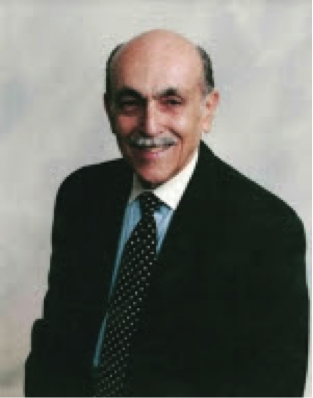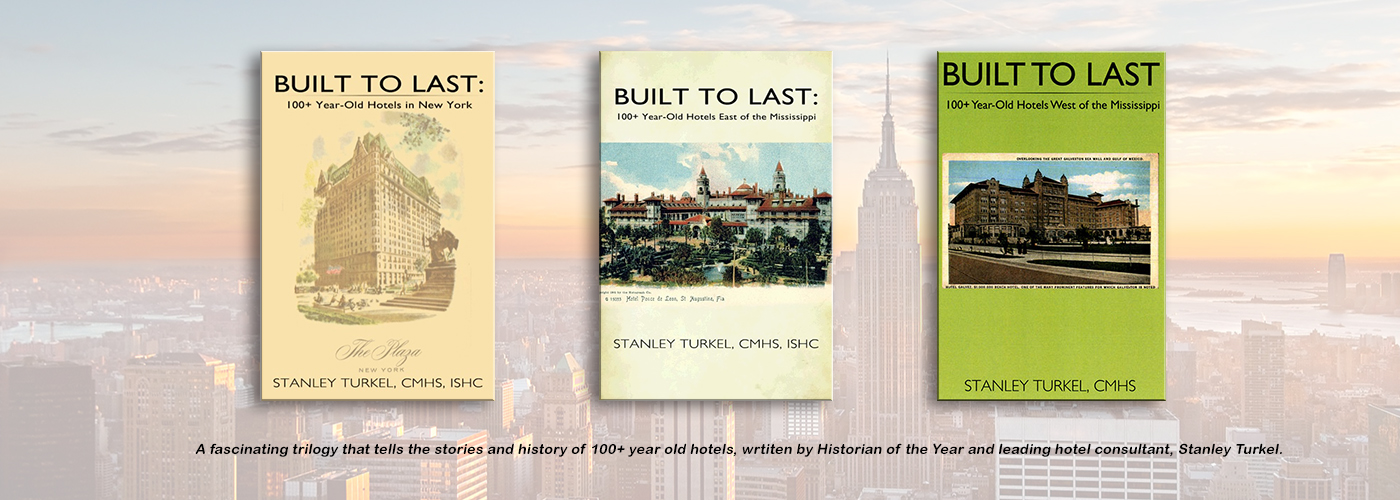Nobody Asked Me But… No. 231: Brown Palace Hotel, Denver, Colorado
Stanley Turkel | May 19, 2020

By Stanley Turkel, CMHS
Hotel History: Brown Palace Hotel, (479 rooms)
The Brown Palace Hotel opened in 1892 with an eight-story atrium designed by architect Frank E. Edbrooke (1840-1921). More than 400 wrought iron grillwork panels ring the lobby from the third through the seventh floors. Two of them are upside down, one to serve the tradition that man is imperfect; the other sneaked in by a disgruntled workman.
The Brown Palace was built on a cow pasture by Henry Cordes Brown, a carpenter who had driven an oxcart across the country and arrived at Cherry Creek in Kansas territory in 1860. By the late 1880s, Brown owned much of the former miner’s encampment that became Denver. He built homes, stores and churches on most of it and gave a parcel to the state for a site for the State Capitol. The Windsor Hotel, one of Denver’s most prestigious hotels, offended Brown by refusing to admit him because he was wearing cowboy clothing. Brown decided to build a hotel that would put the Windsor to shame while allowing cowboy attire. Construction of the Brown Palace Hotel began in 1888 on the Italian Renaissance building using red Colorado granite and Arizona sandstone for the building’s exterior. Because no wood was used for the floors and walls, the hotel was celebrated as the second fireproof building in America.
Architect Frank E. Edbrooke, a Civil War veteran, was termed the “dean” of Denver architecture and several of his surviving works are listed on the National Register of Historic Places. Artist James Whitehouse was commissioned to create 26 medallions carved in stone, each depicting a native Colorado animal. These “silent guests” can still be seen between the seventh floor windows on the hotel’s exterior.
For the interior, Edbrooke designed an atrium lobby with the balconies rising eight floors above ground surrounded by cast iron railings with ornate grillwork panels. The completed hotel cost $1.6 million and another $400,000 for furnishings- a remarkable sum for the time. It included Axministers, Wiltons and Brussels carpets; Irish Point, Clury and Brussels net curtains; Irish linen; Haviland, Limoges and Dalton china; Reed and Barton silver. All the furniture was solid wood in white mahogany, antique oak and cherry. Chairs and sofas were covered in silk. Each guestroom had its own fireplace with kindling and coal provided by bellboys.
At opening the hotel was known as the H.C. Brown Palace. Henry Brown died in San Diego, California in 1906 at the age of 86. His body was returned to Denver where permission was given by the governor for it to lie in state in the capital building, built on the land with which he’d clinched the proposition for Denver’s becoming the Territorial Capitol.
On May 24, 1911, a scandalous double murder took place at the Brown Palace which is reported in the book by Dick Kreck Murder at the Brown Palace: A True Story of Seduction and Betrayal. The story involves high society, adultery, drugs and multiple murders.
Beginning in 1905, every president since Theodore Roosevelt has visited the hotel except Calvin Coolidge. President Dwight Eisenhower was such a frequent guest that the hotel was called the western White House.
Every year since 1945, the hotel lobby is the site of the Stock Show championship when a fifteen hundred to two thousand-pound steer is on exhibit. In its storied history, the hotel has hosted Buffalo Bill Cody, John Philip Sousa, several Barrymores, Lillian Russell, Mary Pickford and the Beatles. Almost every Denver resident has a story of a birthday, anniversary, wedding or other affair held at the Brown Palace. The tradition of “taking tea” is a long-standing one, guests have been doing it for over a century. Afternoon tea is still served daily in the middle of the atrium lobby, accompanied by either a pianist or harpist. Specially commissioned Royal Doulton bone china graces each table along with engraved silver tea pots. No detail is overlooked, not even the silver tea strainers. Afternoon tea includes scones, pastries and delicate tea sandwiches prepared fresh every day. Devonshire cream is shipped directly from England. Guests can choose between the traditional Brown’s tea or the Royal Palace tea. Uniformed wait staff are trained in the art of English tea service, a rare accomplishment in mid-America.
By 1974, the concept of luxury had changed. An average of sixty percent of Brown Palace guests were attending conventions. They were accommodated by construction in 1959 of the 22-story tower building across the street that doubled the size of the hotel from 226 rooms to 479 rooms. By the mid-1990s, Denver opened a new $4.9 billion international airport and rejuvenated its downtown with new stores, new restaurants, new cultural attractions and a new ball park.
While the Windsor Hotel was demolished in the 1950s, the Brown Palace has never once closed its doors since opening 128 years ago. It remains, a magnificent four-star hotel in the heart of one of America’s supreme mountain ranges. The Brown Palace is known for many special qualities: its unusual shape, stunning eight-story atrium lobby, elegant atmosphere and its singular ability to treat guests like royalty. In the Palace Arms restaurant, guests can see two golden eagles made of papier mache- parade decorations from Napolean’s march from the Arc de Triomphe to Notre Dame to crown himself emperor.
In 2013, the Brown Palace received a three-year restoration of the building’s façade by the Denver-based Building Restoration Specialties Company which replaced mortar joints, small areas of damaged stone and repaired flashings. The stone used to replace damaged areas of the façade was hand-carved, custom-made Utah sandstone. From the hand-painted wallpaper in the formal dining area and the on-site well used for drinking water to the painted glass ceiling that showers light on patrons enjoying tea in the atrium, the Brown Palace has managed to stay current without shedding its history.
In 2014, Crow Holding Capital Partners, an investment arm of the Trammell Crow family in Dallas acquired the historic Brown Palace Hotel & Spa and adjacent Comfort Inn Downtown Denver. In 2012, the hotel joined Marriott International’s Autograph Collection of luxury properties.
My New Book “Hotel Mavens Volume 3: Bob and Larry Tisch, Curt Strand, Ralph Hitz, Cesar Ritz, Raymond Orteig” has just been published.
My Other Published Hotel Books
- Great American Hoteliers: Pioneers of the Hotel Industry (2009)
- Built To Last: 100+ Year-Old Hotels in New York (2011)
- Built To Last: 100+ Year-Old Hotels East of the Mississippi (2013)
- Hotel Mavens: Lucius M. Boomer, George C. Boldt, Oscar of the Waldorf (2014)
- Great American Hoteliers Volume 2: Pioneers of the Hotel Industry (2016)
- Built To Last: 100+ Year-Old Hotels West of the Mississippi (2017)
- Hotel Mavens Volume 2: Henry Morrison Flagler, Henry Bradley Plant, Carl Graham Fisher (2018)
- Great American Hotel Architects Volume I (2019)
All of these books can be ordered from AuthorHouse by visiting www.stanleyturkel.com and clicking on the book’s title.
If You Need an Expert Witness:
For the past twenty-seven years, I have served as an expert witness in more than 42 hotel-related cases. My extensive hotel operating experience is beneficial in cases involving:
- slip and fall accidents
- wrongful deaths
- fire and carbon monoxide injuries
- hotel security issues
- dram shop requirements
- hurricane damage and/or business interruption cases
Feel free to call me at no charge on 917-628-8549 to discuss any hotel-related expert witness assignment.115
ABOUT STANLEY TURKEL

Stanley Turkel was designated as the 2014 and the 2015 Historian of the Year by Historic Hotels of America, the official program of the National Trust for Historic Preservation. This award is presented to an individual for making a unique contribution in the research and presentation of hotel history and whose work has encouraged a wide discussion and a greater understanding and enthusiasm for American History.
Turkel is the most widely-published hotel consultant in the United States. He operates his hotel consulting practice serving as an expert witness in hotel-related cases, provides asset management and hotel franchising consultation. He is certified as a Master Hotel Supplier Emeritus by the Educational Institute of the American Hotel and Lodging Association.
Website: (www.stanleyturkel.com)
stanturkel@aol.com/917-628-8549
Categories
- Industry Happenings (25,517)
- Technology (4,821)
- Operations (3,716)
- All Things Independent (3,714)
- Latest news (3,358)
- Market Reports (1,583)
- Development (1,367)
- Finance (1,168)
- Smart Strategies (985)
- Real Estate (975)
hotelonlinenewsInstagram post 18072439732009889Instagram post 18037678936156831Instagram post 17870090452391124Instagram post 17976176743256949Instagram post 17993811919233333Follow on Instagram
Tags
brown palaceBrown Palace Hotelhotel historynobody asked mestan turkelstanley turkelthe brown palace
RELATED NEWS:
Nobody Asked Me, But… No. 230: Hotel History: Four Seasons HotelNobody Asked Me, But… No. 239: Hotel History: Admiral Fell InnNobody Asked Me, But… No. 228: The Barbizon Hotel, New YorkNobody Asked Me, But… No. 227: Hotel History: The Carlyle Hotel, New York (1929)Nobody Asked Me, But… No. 226 Hotel History: Peninsula Hotel, New YorkNobody Asked Me, But… No. 225: Hotel History: The Grand Hotel, Point Clear, AlabamaNobody Asked Me, But… No. 224: Hotel History: The Red Lion InnNobody Asked Me, But… No. 223: Hotel History: The Wales Hotel (1902)Nobody Asked Me, But… No. 222: Hotel History: YMCA of Greater New YorkNobody Asked Me, But… No. 221: Hotel History: Hotel FlorenceNobody Asked Me, But… No. 220: Hotel History: The Heathman HotelNobody Asked Me, But… No. 219: Hotel History: Josh Billings on Hotels One Hundred and Forty-Eight Years AgoStolen Coffee Pot Wins New Orleans Local $15,000 Roosevelt Hotel StayThe Brown Palace Hotel and Spa Names Rodney Herwerth as Complex Executive ChefNobody Asked Me, But… No. 218; Hotel History: Raymond Orteig and Charles LindberghNobody Asked Me, But… No. 217, Hotel History: Catskill Mountain Resort HotelsNobody Asked Me, But… No. 216: Hotel History: Ellsworth M. StatlerNobody Asked Me, But… No. 215: Hotel History: The TWA HotelNobody Asked Me, But… No. 214: Hotel History: Shepheard’s Hotel, Cairo, EgyptNobody Asked Me, But… No. 213: Hotel History: Sheraton’s Classic Advertising Campaigns
